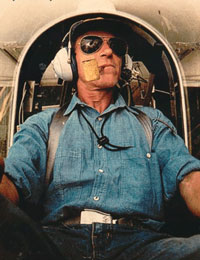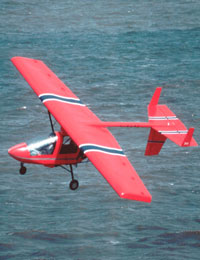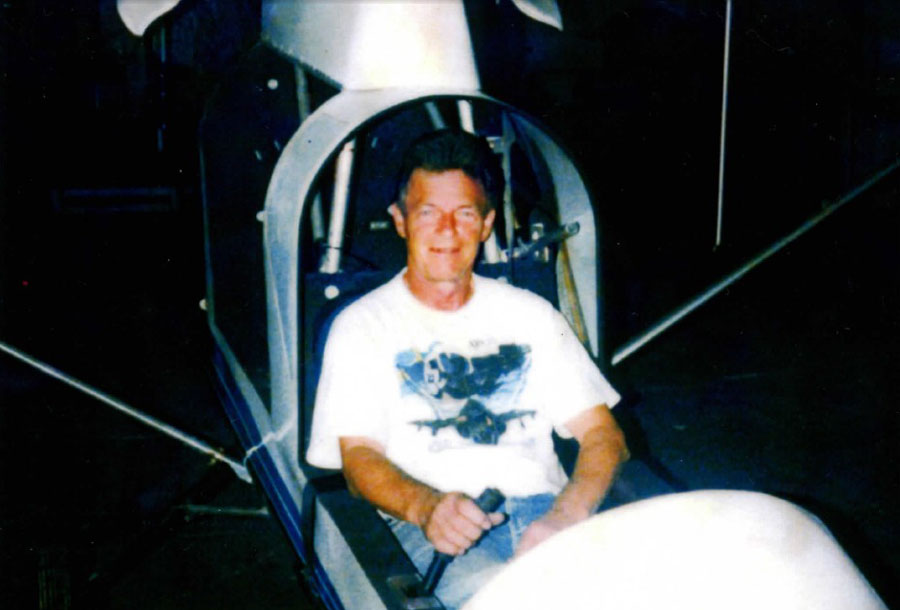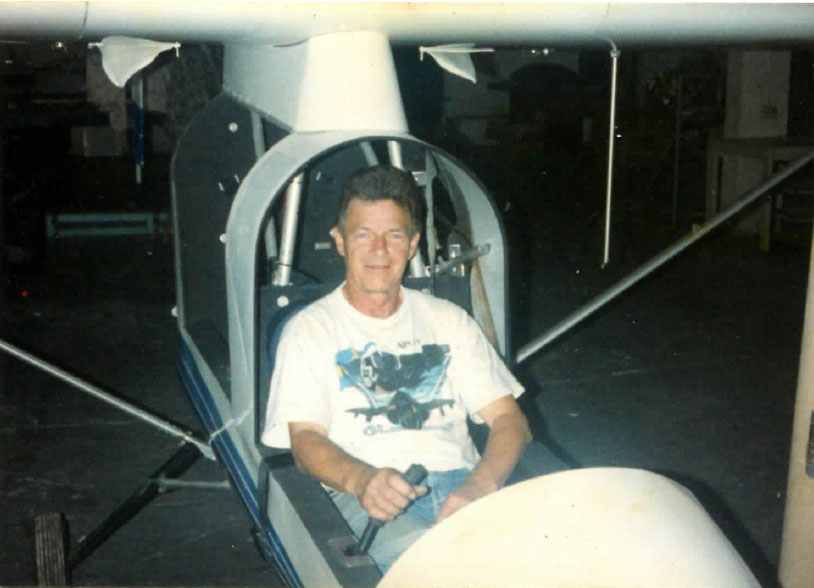I have noted recently on the forum,that a question/s were asked weather vortex generators would work on the Streak Shadow wing-or not. Well yes they do, in my experience anyway. I started building my Streak in 1996 and first flew it in 1998 and I think this Streak was probably, or may have been the first in the world that was completly Full House, in other words the engine (80 HP Jabiru) was fully enclosed as well as the under belly fuel tank and a few other innovative streamlining mods, with quite a fair amount of additional weight being added (dry weight +-240kg) therefore I was already looking at ways to improve lift performance due to the weight. With the help of a local universities aeronautical division who worked out a formula, size/angle and spacing of the generators, these were fixed along the entire length of the top of the Streaks wing at specific intervals.
The first big noticeable change was that the buffeting of the air turbulance across the upper surface of the wing dissappeared completly when the Streak was stalled nose up, or mushed, and that with the forward air speed of 10-20 mph with a decent rate of 2-300 fpm ,and with full flying control still being maintained. This was always a problem before fitting the VG's as the entire air frame "bounced" before the installation on stalling, with the air flow breaking up over the upper surface of the wing.Actually it bacame an absolute pleasure to literally stop flying sometimes, with the engine idling, full elevator up,full flaps on,hard rudder left or right, to mush down literally turning within the streaks length, 360 degree cartwheeling down at 2-300 fpm normally done at about 5000ft altitude, and never ever dropping a wing, and always with positive control throught the rudder. I wonder if Mr Cook ever envisaged his creation to be able to literally drop out of the sky in this fashion without it ever reacting adversly or becoming uncontrollable. If I ever did over shoot a runway, because of the slippery airframe,or was too high on finals,there was no need to go around or sideslip, not being recommended for the Streak, I would simply haul the Streak into a semi stall, literally stop in mid flight,let her mush, with a gentle sink, with no adverse reaction in any way, back on to the power, and continue with finals. This type of manouvre was only done after years of practice however after seeing that there appeared to be no apparent danger, and always with height and safety in mind.
I further noticed that there appeared to be a better penetration at a higher speed with a tendancy to fly with a nose down attitude and could cruise at higher speeds, straight and level, with all up weight, 450 kg, being clocked at 115 mph, at 5000ft alt and could land at much slower than the recommended speed, +- 39 mph at 2600ft alt.The VG's showed that they were performing well due to the dust trail patterns down the wing, reaching right down to the trailing edges, indicating very little or maybe no breakup of the upper boundary layer of air.
Further modifications were to place six stall fences on the upper wing surfaces, starting with the wing tips...no adverse reaction, then halfway down the wing ...no adverse reaction, then on the inner surface in front of the flaps. ie controlling the air flow directly on both sides of the flaps, and the result..the Streak popped upwards, basically forcing a slower decent speed or far less flap on finals, than what was normally required.
I also feel this had a direct effect of getting the air over the wing a bit quicker, and in a sense, kept the air flow directly over the wing, resulting in a better performance all round . The last modification was to the gaps above the ailerons, and here I covered the top surface of the ailerons with very thin strips of metal, without having any contact with the ailerons, to smooth out the trailing airflow before it reached the ailerons. And the result...a far better turning response lighter control with a quicker response all round.
Overall I feel the modifications that were done bit by bit over a period of time certainly enhanced an already brilliant wing, and in my experience created no known adverse effects or percieved danger, and that was after ten years of flying practically every weekend, in the harsh high altitude South African conditions.To those who watch National Geographic, there was a programme recently...about two years ago that featured the greatest fish shoal on earth, and much of the aerial footage was shot from this Streak ...blue stripes along the sides with the distinct six stall fences on the upper wing.
None of thes mods were ever done without the input, help and guidance of our good friend David.
Greg Pedersen
South Africa ZU-BFO
................................................................................
Further information and articles from Greg
Photos of the Modifications
To enlarge click on to the photo, repeat to shrink
This is the one and only known picture of David (not a good copy) taken when he was out in South Africa, I think beginning of 1997 sometime, sitting in my Streak in the Shadowlite factory, before I had started the modifications and If I remember correctly that's when this plan was hatched to do the modifications then, when we spent quite a lot of time together, and maybe David you will confirm the year and especially the month more accurately. Greg
|
|
|
|
|
|
|
|
|
| 1 |
|
2 |
|
3 |
|
4 |
|
5 |
|
|
|
|
|
|
|
|
|
| 6 |
|
7 |
|
8 |
|
9 |
|
10 |
|
|
|
|
|
|
|
|
|
| 11 |
|
12 |
|
13 |
|
14 |
|
15 |
|
|
|
|
|
|
|
|
|
| 16 |
|
17 |
|
18 |
|
19 |
|
20 |
|
|
|
|
|
|
|
|
|
| 21 |
|
22 |
|
23 |
|
24 |
|
25 |
|
|
|
|
|
|
|
|
|
26 |
|
27 Vortex generators |
|
28 Vortex generators |
|
29 Vortex generators |
|
30 |
|
|
|
|
|
|
|
|
|
| 31 |
|
32 |
|
33 |
|
34 |
|
35 |
|
|
|
|
|
|
|
|
|
| 36 Photos before it was sold |
|
37 |
|
38 |
|
39 |
|
40 |
|
|
|
|
|
|
|
|
|
| 41 |
|
42 |
|
43 |
|
44 |
|
45 |
|
|
|
|
|
|
|
|
|
| 46 |
|
47 |
|
48 |
|
49 |
|
50 |
|
|
|
|
|
|
|
|
|
| 51 |
|
52 |
|
53 |
|
54 |
|
55 |
|
|
|
|
|
|
|
|
|
|
|
| 56 |
|
57 |
|
58 |
|
59 |
|
60 |
|
61 |
|
|
|
|
|
|
|
|
|
|
|
| 62 |
|
63 |
|
64 |
|
65 |
|
66 |
|
67 |
|
|
|
|
|
|
|
|
|
|
|
| 68 |
|
69 |
|
70 |
|
71 |
|
72 |
|
73 |
These Photos are from Bruce Conway
|
|
|
|
|
|
|
|
|
| 74 |
|
75 |
|
76 |
|
77 |
|
78 |
|
|
|
|
|
|
|
|
|
| 79 |
|
80 |
|
81 |
|
82 |
|
83 |
.............................
Gregs Photo Gallery
.......................
STREAKS TO THE CAPE
by Greg Pedersen
Saturday, April 27, 2002. Two Streak Shadow fixed-wing microlights, ZU-ANF and ZU-BFO,
piloted by Jas and Greg respectively, from Cato Ridge airfield in Natal, prepared for the long
awaited flight to the southern Cape, a trip that had been weeks in the planning for Greg and a
passion for Jas to visit his father in the Wilderness in his own aircraft, for the last four years.
After chasing off the usual resident cows from the runway, the two of us lined up on 35. The time
06h30. The big trip had begun. Dodging steaming cow patties on the runway, we quickly climbed
out in the cool morning air to 3800 feet and set a course direct for Port St. Johns and settled down to
a steady 70 knot cruise, with a gentle tailwind of about 2-4 knots. We had spent quite some time
in our planning and preparation for this day, so we were able to sit back and enjoy the view and
regularly make use of the chat channel between regular broadcasts.
Our first planned stop came up quickly and we covered this distance in one hour and forty-five
minutes.
Our obligatory ten-minute stop at Port St. Johns airfield was necessary to stretch legs, add liquid to
the cow patties on the strip and contact East London ATC to advise them of our ETA at their field.
Dodging more cow patties and cows on the runway, we left Port St. Johns behind and headed south
towards East London along the coast at 1500 feet. We ate up this distance in a respectable one hour
and thirty minutes, sometimes at ground speeds of nearly 110 knots.
With some helpful chatter with the controller, East London in sight - right hand base - finals - onto
06 and onto the apron for refuelling, with the minimum of fuss. With a quick stretch of the legs, we
headed back out onto 06 but with a difference. Because of the strong cross wind, East London
ground staff accompanied us out onto the runway just in case we were "blown over" in the wind.
Thanks guys.
Off we went like sky rockets again, turned left out of 06 and headed off south with our next stop
being Progress airfield, fifteen kilometres north of Port Elizabeth.
Instead of flying along the coast, we remained about 5-10 nautical miles inland and passed north
of Port Alfred, again with the required chatter to their ATC, surrounding traffic and, of course, our
regular use of the chat channel with numerous comments and discussions on the large green moving
map below us.
Eventually passing over the town of Alexandria, we reached the coast of Algoa Bay and dropped
down to 1000 feet AGL and enjoyed the unusual sight of the sand dunes around Algoa Bay which
stretch for many miles, with Jas doing some whale spotting to boot.
After calling Port Elizabeth ATC, we were kindly allowed through their air space, low level and
proceeded directly on to Progress Airfield where we were welcomed by Progress flying school
personnel and some very excited family members who were now finally convinced that one certain
Streak Shadow ZU-ANF (oops) could actually fly past the borders of Natal.
This leg of our journey south had taken one hour and fifty minutes and by now bums were getting a
bit sore.
By this time John, our old flying buddy originally from Cato Ridge, had joined us with his
Bushbaby BBW with all the "whistles and hooters' going on his arrival, to 'escort' us back on the
last leg of our journey to Plettenberg Bay to visit his new 'digs'.
Tummies full of goodies, the three of us hopped back into the warm afternoon sky and headed
south and formated into our old usual loose triangle.
The chat channel was now 'on fire'. BBW was back with his old flying buddies and making a meal
of every moment.
We had by now encountered a 5 - 10 knot headwind and still had approximately 100 miles to cover
to Plett. To add to the sore bums, fog had formed over the sea and was creeping over the coastal
forests at a rate of knots adding a bit of excitement, trepidation, speculation and very lively chatter
on the radio as to whether we would actually make it to Plett in time. As luck had it we did, but
only by the skin of our teeth in a time of one hour fifty minutes, just before the mist closed in. We
finally landed on a farm in Plett.
The trip down had taken us a total of six hours fifty-five minutes flying time, covering just over 600
nautical miles and had largely been a breeze except for sore bums and the last thirty minutes of
uncertainty and breath holding. Three very happy pilots thankfully parked their toys under the trees
in the mist late that afternoon and 'buggered off into Plett to celebrate the almost uneventful but
scenic trip down.
The next day brought a beautiful, warm, cloudless sky and no fog. The three of us - ANF, BFO and
BBW wasted no time in waking up sleepy old Plett by giving the local population a memorable
display of formation flying along the coastline.
The next few days were largely uneventful and we spent time exploring the rugged coastline around
Plett and Knysna, visiting various airfields, family and friends.
Unfortunately our trip was to be cut short and we reluctantly decided to head for home because of a
series of huge cold fronts rolling in across the Atlantic which threatened to be around for a good
many days, eventually bringing the first snowfalls of winter.
Eager to get home, our first scheduled stop was to be East London Airport. So, very early on 4 May,
we broke loose from Plett and headed east long the coast straight into an incredible sunrise over the
Tsitsikamma Berge. With the chat channel on fire again, we eventually parted company with our
host, John, who peeled off back south after accompanying us as far as the Storms River bridge.
That's when strangely the chat channel died!
We were once again left with our own thoughts and the incredible moving map of the southern
Cape below us.
Our first unscheduled stop was at Beula's Strip just north of Jeffery's Bay, due to certain mounting
pressures in our lower extremities which could and would not wait.
So, after dropping out of the morning sky like downed pheasants, we landed on what we can only
describe as a bowling green, or certainly good enough to be one, and were greeted by the friendly
and amused owner, Bruce Johnson, who came out to see what all the racket and fuss was about so
early in the morning, what manner of birds had landed on his field and why we were in a hurry and
not staying for coffee.
�
The first leg of our journey had so far taken one hour and forty minutes.
Pleasantries exchanged and compliments given in respect of the venue, we roared back into the
morning sky and headed east over part of the Elandsberge roughly north-west of Uitenhage low
level in order to keep out of Port Elizabeth ATC's hair as much as possible. Flying low over flat
scrubland of this part of the Eastern Cape, we eventually joined up onto our original route over the
town of Alexandria, passed north of Port Alfred and headed onto East London and were once again
brought in with the minimum of fuss by East London ATC, duly directed onto the apron for
refuelling and were parked almost under the wings of the five resident SA Airbuses littering the
apron -a case of little boys with the big boys!
This leg of the trip took two hours and twenty minutes due to north-easterly winds increasing in
strength from 5 to 15 knots.
By the time we were ready to leave, the wind had picked up, now gusting to between 12 and 20
knots. Henk, air traffic controller on duty that day, decided to direct us down runway 06 then onto
the end of runway 11, directly into the wind for departure. It's not often one has a chance to depart
from the wrong end of a major runway. We both went up like sky-rockets after a run of only about
fifty to 100 metres, no doubt much to ATC's amusement with the accompanying good humour
from Henk for certain reporting errors by us as we flew north over East London!
The leg to our next stop, Port St. John's, proved to be the bumpy part with winds gusting up to 30
knots at times and conditions becoming very interesting trying to keep the two Streaks straight and
level over the hills of the Transkei coast. At times it felt like we were standing still.
Port St John's in sight, we literally dropped onto the deserted airfield like helicopters, between the
resident cows who were stationed at both ends of the runway like sentries, and a few in the middle
for good measure that refused to budge, just to make life a bit more exciting.
This leg had taken two hours' flying time and was a short stop only to stretch legs and to re-water
some of the dried up cow patties we missed on the way down. With winds now gusting up to and
above thirty knots, we literally took off from a standing start and immediately climbed to 2500 feet
in seconds.
Setting course direct for Cato Ridge on our final leg, proved once again to be very bumpy with
some 'up-lifting' and hair-raising moments, with strong updrafts rising out of the valleys, keeping
us wide awake for the rest of the trip.
However, the 'fun' was not quite over. With the cloud base dropping and mist looming over the
Umkomaas Valley in the late afternoon, we now had to find a way through this lot, so the race was
on once again to see if we could make it home without having to divert somewhere else. As luck would have it, Mother Nature was kind to us and left convenient gaps, sometimes
sparingly, between the clouds, foothills and treetops, probably with the knowledge that Streaks can
out-manoeuvre most obstacles and we eventually made it safely home by the skin of our wingtips.
The last leg had taken two hours and thirty six minutes and shortly after landing Mother Nature shut
the door on flying for the rest of that day.
The journey home had taken us eight hours and thirty-six minutes flying time with both aircraft
performing faultlessly.
We had done it!! That evening two 'happy campers' put their toys to bed and wearily wended their
way home through the thick mist, which had now enveloped the airfield in a white cocoon.
At least one pilot was smug in the knowledge that his toy could actually fly out of Natal safely (Jaslike!).
Footnote for microlight pilots : Our thanks to Henk Holtzhuizen, his staff and groundstaff at East
London ATC for their friendly assistance on our arrival and departures. Jas and I had both spoken
direct to ATC and had also advised them by fax the week before of our planned route, ETA to their
field, aircraft types and capabilities, and our knowledge of the area - or, in our case, the lack of it which
made ATC aware of what to expect. It really made life easier for all on the day and they were
appreciative of our forward planning.
Henk advised us on the best times for approach and landing during the day so as to avoid all the
heavy metal, so on both the down- and upward legs, we literally had the place to ourselves. We did
hear that there have unfortunately been certain pilots flying along the coastline in full view of East
London ATC who had not radioed their intentions to the tower, resulting in some very frustrated air
traffic controllers. No wonder microlighting gets a bad name because of one or two pilots who spoil
it for everyone.
Hopefully this footnote will inspire forgetful microlight pilots to talk to ATC whenever and
wherever required for their own safety and the safety of others, which can only improve the image
of microlighting and make for better relations between all. ATC are not the enemy and we were
made most welcome.
|
|
|
|
|
|
|
|
|
| 84 |
|
85 |
|
86 |
|
87 |
|
88 |
| |
|
|
|
|
|
|
|
|
| |
|
89 |
|
90 |
|
91 |
|
|
| |
|
|
|
|
|
|
|
|
| |
|
|
|
These 2 photos were
taken 9th October 2011
Sadly at the moment its not being flown |
|
|
|
|
| |
|
92 |
|
|
|
93 |
|
|
Photos from Greg Pedersen and Bruce Conway
...................................................................................................................
Streak Shadow ZU-BFO has now passed on to a new owner
Eric Webber (SA)
Here are a few photos from Eric
|
|
|
|
|
|
|
|
|
| 94 |
|
95 |
|
96 |
|
97 |
|
98 |
|
|
|
|
|
|
|
|
|
| 99 |
|
100 |
|
|
|
101 |
|
102 |
These photos were taken in 2009 at a little airfield called Grassroots, in Kwa-Zulu Natal where the Streak was based. The pictures are first static, and then in the air. Note that Eric had removed the underbelly pod in the static pictures, while in the aerial shots, the protective underbelly pod is still on.
|
|
|
|
|
|
|
|
|
| 103 |
|
104 |
|
105 |
|
106 |
|
107 |
|
|
|
|
|
|
|
|
|
| 108 |
|
109 |
|
110 |
|
111 |
|
112 |
These photos were taken in 2008 off the Southern Cape Coast in an area called Plettenburg Bay (SA)
Photos from from Eric Webber via Greg Pedersen














































































































